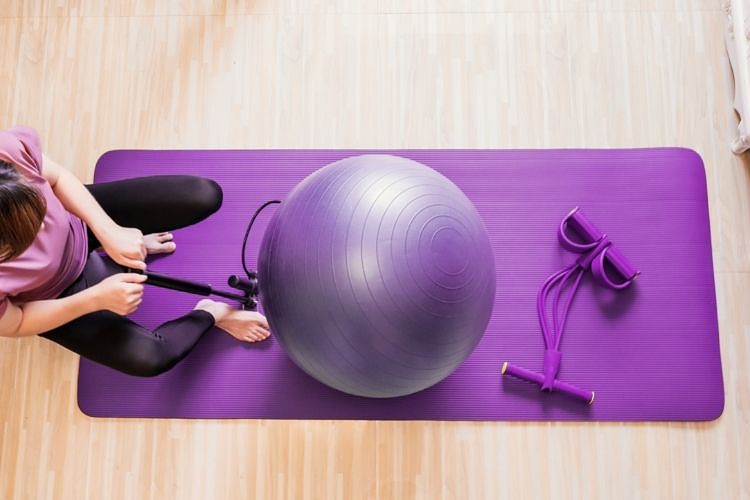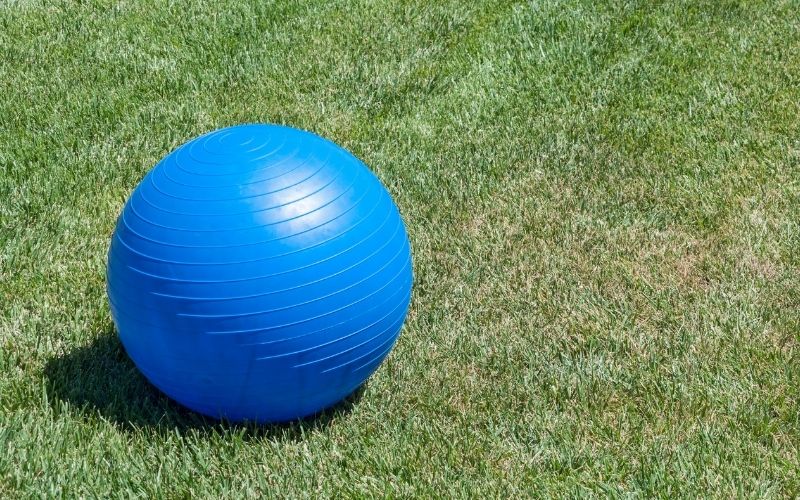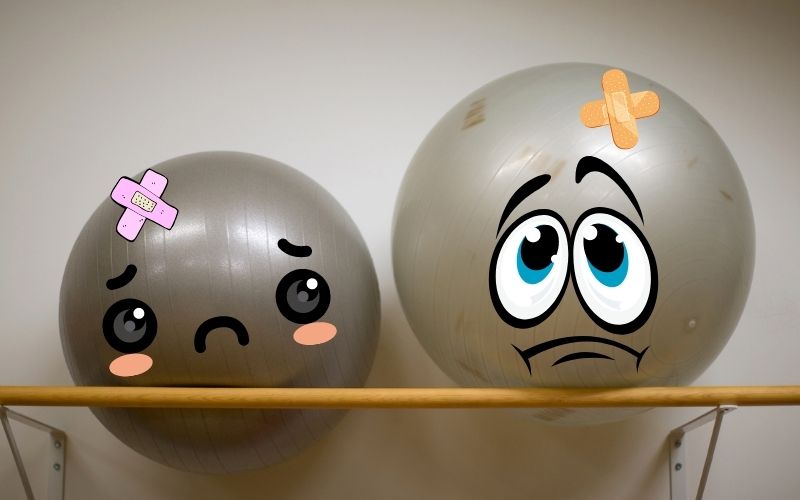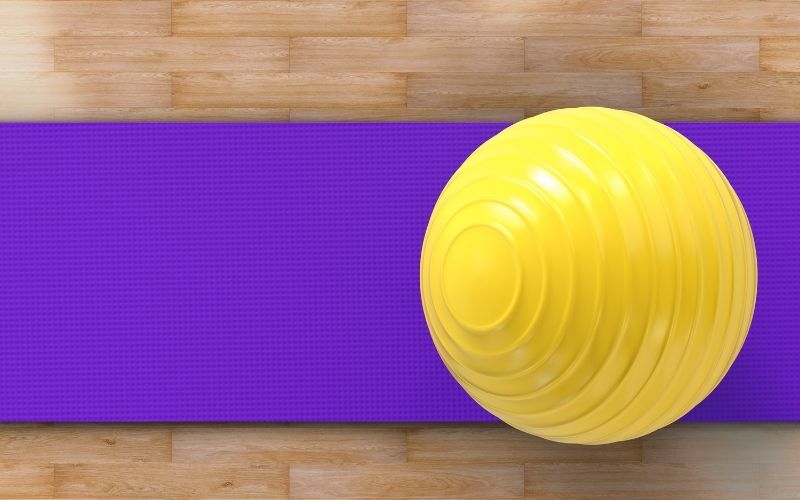You bought your exercise ball not too long ago and it’s already deflated!
You may be questioning why your exercise ball keeps deflating and if there are ways to prevent this from happening. Your exercise ball keeps deflating due to one of these five reasons: it is overfilled, constantly used, has a broken plug, atmospheric pressure/low temperatures, or it has a hole.
When you rest your hand on an exercise ball, there should be enough air in it to allow your hand to sink into it a few inches. Keep reading for more details about the reasons your yoga ball continues to deflate.
Table of Contents
Why does my exercise ball keep deflating?
The reason your exercise ball keeps deflating is due to one of these causes:
- Too much air
- Frequent usage
- Bad plugs
- Weather pressure and cold temperatures
- Puncture holes
Let’s dive into some more details regarding each of these five causes to help you better understand what is happening to your stability ball.
Too Much Air
It is possible to overfill an exercise ball. Usually, people who are new to stability balls don’t understand that their ball should not feel like a rock.
When you overfill an exercise ball, you place a lot more pressure on the ball’s surface. This forces the plug to loosen which causes it to leak air.

If it’s the first time you’re inflating your stability ball, then the aim should be to fill it to 80 percent of its capacity. Let your ball sit overnight and then come back and fill it to your specific ball’s recommended size.
Even if it isn’t your first time, your ball should have some give in it.
A good way to measure the give in your ball is by placing your hand on the top of your air-filled exercise ball and putting your weight into it. Your hand should sink six inches into the ball.
Frequent Usage
The more you use your yoga ball, the faster it will deflate. Filling your ball with too much air and frequent usage have similar causes for why they lose air.
The added pressure on the ball from your body weight slowly pushes the air out through the plug. It’s important to maintain your exercise ball and fill it whenever it’s needed.

A lesser-known fact surrounding exercise balls is the change of their physical appearance over time. With frequent usage, the plastic material on the exercise ball wears thin, making them more prone to issues like deflation or bursts.
The Plastic Expert Group did a study on how “burst-resistant” exercise balls can explode and cause serious injury.
Within this study, they discuss the difference between ruptured and not ruptured surface cells on an exercise ball.
The most obvious cue of ruptured plastic surface cells on an exercise ball is its lack of shiny reflectiveness.
If your exercise ball no longer has a shine, then it most likely has ruptured surface cells.
The ruptured surface cells will cause your ball to have thinner walls, making it easier for air to escape. If the ball looks dull, then your ball has a higher likelihood to burst.
Bad Plugs
A bad plug that causes an exercise ball to deflate isn’t always the user’s fault. Sometimes manufacturers are in a rush during the manufacturing process which creates defects in exercise ball plugs.
On the other hand, damage to the plug can be caused by the user. Technically speaking, you should always use the prong plug remover that sometimes comes with the ball when first bought.

can be bought on Amazon in case you never got one or lost yours.
These prong plug removers are specifically designed to prevent damage to a stopper. The prongs slide on both sides of the exercise ball plug and from there, you gently pull upwards.
You’ll notice quite a few people using other miscellaneous tools to get their yoga ball plug out.
These random tools can make the process of getting your exercise ball plug out more difficult, though it can be done.
If you decide to use a makeshift plug remover, don’t use something with sharp edges or points or you could damage the plug.
Let’s say it’s too late and you think your plug is already damaged.
In that case, you can also go on Amazon and order new plugs that come in multiple sizes to fit your specific ball. Some products even come with a plug remover. How convenient!
Weather Pressure and Cold Temperatures
The air inside a football works the same way as the air inside a yoga ball, or any other ball for that matter.
Just like footballs when they are left out in the cold, exercise balls can also lose air in colder temperatures.

Simply stated, when temperatures drop and get colder, atoms inside the ball slow down leading to a decrease of pressure inside the ball which is why your yoga ball shrinks and loses air.
If your stability ball is deflated and you want to inflate it, manufacturers recommend inflating your ball in a room no less than 68 degrees Fahrenheit. The reason for this is that most people keep their homes at that temperature.
Your goal is to keep your exercise ball in a room that consistently stays the same temperature (give or take a couple of degrees).
When the room temperature fluctuates often, like someone opening and closing a window for cold air, it will lead to your exercise ball deflating.
Another example of inconsistent temperature changes is removing your ball from your home office or exercise room and placing it in your cold garage.
Atmospheric pressure can be another contributing factor as to why your exercise ball continues to deflate.
Unlike the goal of keeping your ball in a temperature consistent room, you don’t have much control over the weather. When storms roll in, it’s normal for the pressure in a room to decrease or increase.
Puncture Holes
An exercise ball’s surface is made of Polyvinyl chloride (PVC), which is a soft vinyl plastic. The key takeaway here is the word “soft.”
Their soft plastic is not invincible to abrasions, tears, and puncture holes. If you sit on an exercise ball or stretch on it on a dirty, bumpy, or pointy surface, then you might puncture a small hole in it somewhere.

Now, for those of you who think a punctured hole is a cause of your exercise ball’s deflation, there is a trick you can do to find the hole.
Here are the steps to check for punctured holes:
Step 1 – Remove the plug, fill your stability ball with air by using a hand pump, and put the plug back in. If it’s not immediately obvious, by the sound of a leak or air felt on your hand when you wave it over the ball, then move onto step 2.
Step 2 – Pour water over your exercise ball while giving it a gentle squeeze. You should see air spray through the water. If this doesn’t happen, then go ahead and rotate the ball and test out another part of the ball with the same water pour method.
Do this until you find the hole. If you can’t locate a hole, then it could be that your ball doesn’t have a hole and the reason your exercise ball is losing air is due to one of the other four causes.
Step 3 – If you did find a hole, wipe the surface around the hole and make a small circle around the hole using a sharpie. This will prevent you from losing track of where the hole is.
Next, you’ll buy Goop Adhesive , an all-purpose clear glue, either online or in a home improvement store to seal the hole.
How do I keep my exercise ball from deflating?

There are many ways you can keep your exercise ball from deflating. Below we’ve listed the best tips on how to prevent your ball from continuously leaking air.
- Don’t overfill the ball with air (proper and recommended air capacity)
- Proper maintenance (keep your eye on the ball!)
- Check the ball regularly for shininess and any signs of degradation of surface cells
- Keep the ball in a temperature-balanced room
- Prevent room temperature fluctuations by keeping windows and doors closed
- Use the ball on smooth surfaces
- Check your ball plug or PVC ball material for manufacturer defects
- When removing a plug, use the proper tool ()
- Don’t use sharp objects to remove the plug
- Patch any holes you find with glue (Goop Adhesive )
- Buy a new exercise ball every 12 months
How do I add more air to my exercise ball?
When it comes time to add more air to your exercise ball, there are a couple of tools that you’ll need and a few steps to follow.
The main tools you will need are a plug extractor/remover and an air pump with the proper sized tip to fit into the hole of your exercise ball.
The air pump you choose to inflate your exercise ball can be a hand-held pump or an electric pump. Both of which have their pros and cons.

A hand-held pump allows you to feel how much air you’re pumping into your exercise ball. But, manual hand pumping is also one heck of a workout!
An electric air pump, like air mattress pumps, vacuum cleaners in reverse, and air compressors, are your other options. They require fewer calories from you, but they are more difficult to sense how full your exercise ball is getting
Here are the steps to add more air to your exercise ball:
Step 1 – Remove the exercise ball plug with a prong plug remover to make it easier for you and safer for the ball plug. Place your finger over the hole to prevent more air from leaking out.
Step 2 – Remove your finger from the hole, place the tip of the hose of your electric or manual hand-pump in the hole, and start inflating your ball with air. Inflate the ball until it has reached its proper and recommended diameter (80 percent capacity if it’s the first time inflating the ball).
Step 3 – Remove the hose from the ball and place your finger on the hole again to prevent any air from sneaking out. Then replace the ball plug inside the hole. Make sure the plug is sitting in the hole firmly.
If it’s the first time you fill your exercise ball with air, remember to only fill it to 80 percent of its recommended air capacity. Let your ball sit for 24 hours and refrain from using it until the next day.
On the second day, you’ll repeat steps one through three until the ball is at its recommended size. Then it’s time to have fun with it!
If you need some ideas on how to have fun with your exercise ball, then check out our article, “10 Fun Things to Do With an Exercise Ball.”
Conclusion
We hope our five causes of why your exercise ball keeps deflating helps you solve your dilemma. The tips we’ve provided can be applied today to help extend the amount of time air stays in your exercise ball.
With a prong plug remover and an air pump, your exercise ball will be pumped up in no time!

My name is Vance, and I am the owner of To Ergonomics. Our mission is to improve your workflow by helping you create a supportive and welcoming environment. We hope that you’ll find what you’re looking for while you’re here.

